While I was preparing the notes for Gina Bachauer’s Mercury recordings for Eloquence, the label provided me with another commission for an artist I was less familiar with: Bella Davidovich, whom I of course knew of but not as well as I ought. The producer of the set put me in contact with Davidovich’s son, violinist/conductor Dmitry Sitkovetsky, with whom I had a phenomenally engaging and illuminating conversation that provided the foundation for my investigation into this pianist’s artistry. Below the promo video for the set are my notes for the production of her complete Philips recordings (click here for more about the set).
Bella Davidovich: The Philips Legacy
By Mark Ainley
When Bella Davidovich made her Carnegie Hall debut in 1979, the over-capacity audience spilling onto the stage must have reminded her of a breakthrough experience three decades earlier. The Russian pianist had participated in the 1949 Chopin Competition in Warsaw, where the aisles overflowed with locals clamouring to hear the music of the beloved composer. Davidovich tied for first place, an outcome that was the starting point of a distinguished career back home, just as her Carnegie Hall recital would be the beginning of a new chapter for the 51-year-old musician whose name had for years been pronounced with reverence amongst the cognoscenti of piano fans. Today, well after her retirement, Davidovich continues to be esteemed as one of the greatest pianists to emerge from post-War Russia.
Musical beginnings
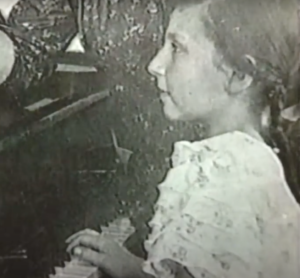 Bella Davidovich was raised in an ideal environment for nurturing her innate musical inclinations. She was born on July 16, 1928 in Baku in Azerbaijan, where her mother was a piano coach at the same Opera House at which her own father was concertmaster. This city may not be as known in the West for its status as a major cultural centre, but along with Moscow, Leningrad, and Kyiv, Baku was home to a rich musical scene that hosted the greatest touring musicians (Mstislav Rostropovich was also born there), so Bella was surrounded by music from the very beginning. Because her home had a piano, local singers used to come practice in their living room, and the family’s radio quickly became one of the young girl’s favourite forms of entertainment. After listening on headphones, she would wander over to the piano and start picking out tunes, and at three and a half years old she began playing Chopin’s Waltz in B Minor by ear – with both hands and in the right key, suggesting that she had perfect pitch (she did).
Bella Davidovich was raised in an ideal environment for nurturing her innate musical inclinations. She was born on July 16, 1928 in Baku in Azerbaijan, where her mother was a piano coach at the same Opera House at which her own father was concertmaster. This city may not be as known in the West for its status as a major cultural centre, but along with Moscow, Leningrad, and Kyiv, Baku was home to a rich musical scene that hosted the greatest touring musicians (Mstislav Rostropovich was also born there), so Bella was surrounded by music from the very beginning. Because her home had a piano, local singers used to come practice in their living room, and the family’s radio quickly became one of the young girl’s favourite forms of entertainment. After listening on headphones, she would wander over to the piano and start picking out tunes, and at three and a half years old she began playing Chopin’s Waltz in B Minor by ear – with both hands and in the right key, suggesting that she had perfect pitch (she did).
She began formal lessons at the age of 6, gradually expanding her repertoire until at age nine she was invited to perform Beethoven’s First Concerto with the Baku Philharmonic. At the first rehearsal, conductor Nikolay Pavlovich Anosoy (father of the legendary Gennady Rozhdestvensky) had noticed that the young girl was unsettled by having so many musicians next to her when she was used to a second piano in a studio; he gently put her at ease and by the second rehearsal, Bella was already accustomed to playing with an orchestra on stage, and the concert was a spectacular success.
At the age of 12 Bella had an opportunity to play for the visiting pianist Konstantin Igumnov, who stated matter-of-factly that he was not accustomed to teaching children but for Davidovich he would make an exception were the family to relocate to Moscow. Taking advantage of this invitation, Bella and her father moved to a Moscow suburb the following year – being a surgeon he had easily been able to find a job – and the others followed soon after. In her formative lessons with Igumnov, the master helped his young charge refine her technique while introducing her to a pianistic culture centred on tonal colour and respect for the composer’s instructions. But her training would be interrupted a year later by the war, at which time her father was mobilized back to a military hospital in Baku and the entire family moved back.
Post-War Success
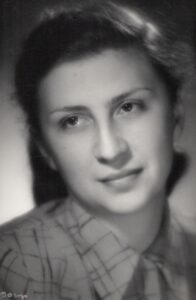 After the War, Igumnov suggested that Bella return to the Moscow Conservatory once she graduated from high school, which she did; however, she was only able to study with him for a bit over a year before he died in March 1948. After carefully considering who her next teacher should be, Davidovich decided upon Yakov Flier because he too had trained with Igumnov, so she was able to continue her training with a consistent technique and approach. Flier remained a dedicated mentor until his death in 1978, Davidovich regularly visiting him to present new repertoire even as she enjoyed a successful career.
After the War, Igumnov suggested that Bella return to the Moscow Conservatory once she graduated from high school, which she did; however, she was only able to study with him for a bit over a year before he died in March 1948. After carefully considering who her next teacher should be, Davidovich decided upon Yakov Flier because he too had trained with Igumnov, so she was able to continue her training with a consistent technique and approach. Flier remained a dedicated mentor until his death in 1978, Davidovich regularly visiting him to present new repertoire even as she enjoyed a successful career.
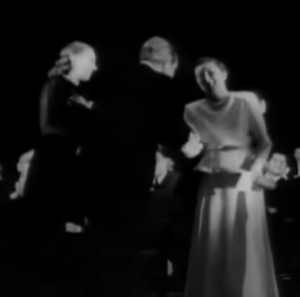
In late 1948 there were murmurs that the Chopin Competition in Warsaw would resume the following year after been on hiatus since 1937. Each teacher at the Conservatory prepared two pupils, and Davidovich was chosen by Flier (along with Liubov Yedlina), even though he wondered whether the 21-year-old might be still a bit too young for such a serious competition. Despite his doubts, Davidovich went to Warsaw for the event.
Successfully navigating the unconventional circumstances of playing on less-than-ideal instruments in a movie theatre (the concert hall had been destroyed in the war), Davidovich shared first prize with Polish pianist Halina Czerny-Stefańska. Although she would continue her studies at the Conservatory until 1956, her success in Warsaw launched her career and Davidovich became one of the premiere female pianists in the Soviet Union: she performed with every major Russian conductor of the time, appearing for twenty-eight consecutive seasons with the Leningrad Philharmonic Orchestra, and she taught at the Moscow Conservatory for sixteen years.
Film footage of Davidovich shortly after her win at the Chopin Competition:
Not long before heading to Warsaw, Davidovich had been accompanying a pupil of violin master Abram Yampolsky and innocently asked who in the practice room might turn her pages. The offer to help came from one Yulian Sitkovetsky, an extraordinary violinist considered on par with Oistrakh and Kogan. Davidovich and Sitkovetsky hit it off and married in 1950, also very quickly becoming a highly respected violin-piano duo. But tragedy struck when Sitkovetsky fell ill, dying of cancer in 1958 at the age of 32, leaving his widow (not yet 30) to care for their young son Dmitry. His death was an irreplaceable loss – Davidovich never remarried – and yet she continued her career as a performer and teacher, while Dmitry would follow in his father’s footsteps to become a violinist, as well as a conductor.
Moving to the West
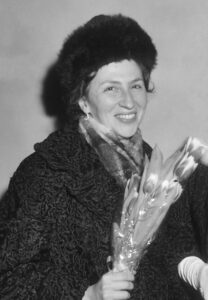 Dmitry left for New York early in 1977 to study at Juilliard, a move he planned to make permanent; he hoped his mother would follow but she refused to leave without her mother and sister, the latter being sick at the time. Although Davidovich had played internationally for many years (she first appeared in London in 1966), once her son left these possibilities began to dwindle. While touring Europe in May 1977, the two were able to meet when she played at the Milan Conservatory but after her return to Russia, a colleague told the KGB that Dmitry had emigrated and both her domestic and international bookings decreased without any formal explanation. A sold-out two-piano concert in Holland slated for February 1978 was cancelled when Davidovich was denied permission to leave; meanwhile, the pianist she had been booked to play with, Ekaterina Novitskaya, was allowed to travel and ended up defecting.
Dmitry left for New York early in 1977 to study at Juilliard, a move he planned to make permanent; he hoped his mother would follow but she refused to leave without her mother and sister, the latter being sick at the time. Although Davidovich had played internationally for many years (she first appeared in London in 1966), once her son left these possibilities began to dwindle. While touring Europe in May 1977, the two were able to meet when she played at the Milan Conservatory but after her return to Russia, a colleague told the KGB that Dmitry had emigrated and both her domestic and international bookings decreased without any formal explanation. A sold-out two-piano concert in Holland slated for February 1978 was cancelled when Davidovich was denied permission to leave; meanwhile, the pianist she had been booked to play with, Ekaterina Novitskaya, was allowed to travel and ended up defecting.
That Milan recital of May 26, 1977 would end up being a stepping stone for the next phase of her international career: an American agent in the audience, Jacques Leiser, had previously heard talk of Davidovich, and after this performance he worked with her son and industry officials to lay the foundations for her career in the West should she leave Russia. Leiser had a nose for talent, having played a role in arranging Sviatoslav Richter’s first European recording in 1957, luring the reclusive Arturo Benedetti Michelangeli out of retirement in the 1960s, and coordinating Lazar Berman’s breakthrough tours of Europe and North America in the 1970s. He spoke of Davidovich to countless industry professionals, circulating a bootleg recording of the Milan recital to agents, writers, conductors, and other key figures worldwide.
It was on the basis of this tape and Leiser’s collaborative efforts with Dmitry that Davidovich would be booked for a Carnegie Hall debut and to record three albums with Philips. The pianist arrived in the United States in late 1978 and settled without fanfare in Queens with her mother and sister living upstairs, starting her new life very modestly – which included limiting her practice time because of complaints from neighbours. With The New York Times announcing her upcoming 1979 Carnegie Hall debut with a lengthy feature entitled “Presenting Russia’s ‘Best Kept Secret’”, the demand for tickets was so great that Davidovich was asked if she would agree to more audience members being seated on stage behind the piano (she did).
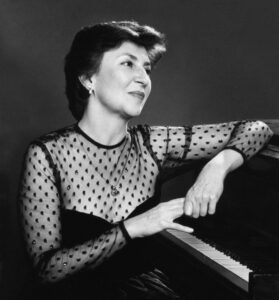 This fabled October 12, 1979 Carnegie Hall appearance was the first sold-out debut recital in the hall since Richter’s in 1960, a prospect that filled the seasoned artist with such nerves that when Leiser asked whether she would like to drive or to be picked up for the concert, she quipped, “Just get me an ambulance!” Davidovich played works by her two favourite composers, Chopin’s 24 Preludes in the first half, Schumann’s Arabesque and Carnaval in the second, and the concert was such a success that her career in the West was assured, with over a dozen other recitals and thirty concerto appearances booked on short notice for the same season.
This fabled October 12, 1979 Carnegie Hall appearance was the first sold-out debut recital in the hall since Richter’s in 1960, a prospect that filled the seasoned artist with such nerves that when Leiser asked whether she would like to drive or to be picked up for the concert, she quipped, “Just get me an ambulance!” Davidovich played works by her two favourite composers, Chopin’s 24 Preludes in the first half, Schumann’s Arabesque and Carnaval in the second, and the concert was such a success that her career in the West was assured, with over a dozen other recitals and thirty concerto appearances booked on short notice for the same season.
The pianist would perform throughout North America and more widely across Western Europe than previously, and she accepted an invitation to teach at Juilliard. Although there were breaks in her teaching schedule due to her tours, her pupil Golda Vainberg-Tatz stated that Davidovich went far beyond the standard conservatory student-teacher relationship: she never strictly limited lessons to one-hour appointments, and as Davidovich said, “No matter what time of year it is, vacation or not, when teacher is in town, it’s school time.” As Flier had for her, Davidovich continued to mentor students after graduation, telling them, “after you play for me, it will be much easier to play for the public.”
Davidovich had been rather despondent at the likelihood of never returning to Russia, but in the spirit of perestroika she was the first emigré musician welcomed back via the Soviet agency Goskoncert in 1988. The following year, she gave a 10th anniversary concert of her debut at Carnegie Hall, and she left her formal teaching position about a decade later. She gradually curtailed her appearances, giving her last public performance in Greensboro, North Carolina in 2011, with her son both conducting and playing with her the Haydn Double Concerto for Violin and Piano.
Davidovich’s pianism and recordings
When she was warming up backstage at the 1949 Chopin Competition, the hall manager asked Davidovich, “Do all the Soviet musicians make the instrument sound so beautiful?” Although she answered in the affirmative, one can certainly consider her own sound world to be particularly exquisite. Igumnov had taught her to hone her touch by practicing pushing down each key without making a sound and then moving to the next key, an exercise that cultivated precision as well as a true finger legato. She maintained this mindful connection with the keyboard with both fingers and ears, telling Vainberg-Tatz, “Please hear every little note, singing sound! Never hit the note, because the piano will hit you back!” and she also insisted that the pedal be used only for colour and not to lengthen sounds. Clarity of texture, beauty of tone, and poised proportion are among the hallmarks of her distinguished pianism.
In the first three decades of her career, Davidovich had recorded over a dozen LPs on Russia’s Melodiya label, performances that were enthusiastically sought out by international collectors at a time when obtaining them was no easy feat. So little was known about her in the West that veteran critic Harris Goldsmith in 1962 mistakenly referred to her by the male Hungarian name Bela while praising her Melodiya LP of Chopin’s F Minor Concerto as ‘strong, manly account of the music’ and noting that ‘his pianism is very similar to Rubinstein’s.’ Harold C Schonberg had considered what records he’d heard to be tantalizing and upon visiting Russia and hearing Davidovich play in 1967, he declared that she “deserves to be heard in the capitals of the world.”
Her successful debuts in the West heralded recordings for Philips that evolved from an initial three-record deal to a total of ten releases of solo and concerted works that reflect Davidovich’s intelligently crafted and impeccably cultivated artistry. While the main focus was Chopin, she also recorded an album each of Schumann and Beethoven, another featuring both Scriabin and Prokofiev, and piano & orchestra works by Saint-Saëns & Rachmaninoff.
Some critics found the pianist’s consummate command and exceptionally clean playing to be somewhat impersonal – interesting given the pianist’s own statement that “as a performer, it is necessary and inevitable that you combine your own personality, if you have one, with the thoughts and intentions of the composer” (and she certainly never lacked personality). At a time when so many pianists overuse the pedal instead of playing with true finger-legato phrasing and when timing adjustments are often willful rather than incorporated into the musical architecture, Davidovich’s transparency, directness, and avoidance of exaggeration can stand in such stark contrast as to appear cool in comparison. Yet the warmth of her tone, fluidity of her phrasing, and the intelligence of her conceptions result in interpretations that are inspired while also being disarmingly direct – perhaps not in the same ethereal, otherworldly vein as the readings of some of her colleagues, but nevertheless expansive in scope, giving the impression of having feet firmly planted on the ground while gazing towards the sky.
The Philips Recordings
While Chopin makes up the bulk of Davidovich’s Philips discography, her first album released in 1978 was dedicated to Schumann. Eric Salzman in HiFi Stereo Review rapturously praised her “superb Carnaval, full of fantasy and poetry, as witty and personal and brilliantly played as, well, Rachmaninoff’s.” He found the Humoreske had all the same qualities and may have perfectly articulated the essence of her artistry when he summarized that “Davidovich is one helluva strong player, but she is no showoff: everything is personal, phrased, articulated, sung out, intense, highly poetic.” (Full playlist)
Davidovich set down a number of Chopin cycles for Philips – the Preludes, the Ballades, the Impromptus – along with a few other works such as the Barcarolle, Rondo, and a Polonaise. Max Harrison’s Gramophone review of the Preludes reported that she “always produces a full and lovely tone” and he considered her readings to reveal “playing of high accomplishment,” noting a similarity in some of her pacing to that of the great Paderewski. In comparing her Ballades to Claudio Arrau’s, Harrison observed that “Davidovich makes her points less insistently, and allows the music to speak for itself more directly. Not that hers is other than a thoughtful performance,” particularly praising her ability to maintain clarity with her use of pedal, subtle colouring, and “great sensitivity.” Raymond Ericson in the New York Times found that in the Ballades she “manages to give the music a personal warmth and commitment without distorting the musical architecture or meaning. An impressive disk on all counts.” (Full playlist)
In addition to these solo sets, Davidovich recorded most of Chopin’s works for piano and orchestra. The less frequently played Krakowiak impressed Harrison with its “striking purity and freshness,” while the F Minor Concerto he praised for its “charming piquancy.” In evaluating her E Minor Concerto and Andante Spianato & Polonaise for HiFi Stereo Review, Salzman again seems to have grasped the pianist’s style when he asserted that “unless your entire interest in keyboard playing is acrobatics, I don’t see how you could fail to like Bella Davidovich’s Chopin,” adding that while she lacked nothing technically, “it is clearly the lyricism of this music that interests her.” (Playlist for E Minor Concerto and Andante Spianato; Playlist for F Minor Concerto and Krawkowiak)
For her sole disc of Beethoven, Davidovich presented the Moonlight Sonata and E-Flat Major Sonata Op.31 No.3 along with the ever-popular Für Elise. Richard Osborne in Gramophone observed that there was no doubt that “she is a pianist of character and quality,” even if he believed that her clarity and focus on grandeur overlooked some of the music’s elemental motion and that she could lean towards the “didactic” – yet despite some reservations he acknowledged that her “ample zest for life is evident” in these readings. (Full playlist)
Another departure from the general thrust of her recorded repertoire is a disc of Scriabin and Prokofiev solo works. Gramophone’s review focused primarily on the recorded sound and repertoire selection, though it was stated that the pianist was “no mean interpreter of Scriabin and her account of the G sharp minor Sonata has authority – as, indeed, do the companion pieces.” Davidovich’s sublime colours and pedal effects in excerpts of Prokofiev’s Romeo and Juliet went unmentioned, despite being impeccably accomplished and among the most remarkable qualities of these traversals. (Full playlist)
Though she had nearly 30 works for piano and orchestra in her repertoire, the only ones not by Chopin that Davidovich recorded for Philips were the Saint-Saëns 2nd Concerto and Rachmaninoff’s Rhapsody on a Theme of Paganini. HiFi Stereo Review’s David Hall suggested one listen to other pianists if one merely wanted “glitter” in the Saint-Saëns because the pianist and Neeme Järvi, with the Concertgebouw Orchestra, “take a decidedly more expansive and freely romantic view of the score.” He found that in the Rachmaninoff the two musicians were even more unified and inspired, “responding all-out to the work’s passionate, macabre, and capricious elements” – an approach not unlike that of the composer.
From her earliest years, there was hardly a doubt that Bella Davidovich would devote her life to playing the piano. Her mastery of the art of belcanto phrasing and full-bodied tone production was a throwback to the great 19th century pianists, her approach guided by an unwavering respect for the composers and performers who came before her while aligned with the modern aesthetic of fidelity to the score and modest individuality. Davidovich’s Philips recordings remain an important testament to her dignified pianism several decades after these performances were immortalized, the pianist’s warmth, transparency, and cohesiveness revealing as much of her noble artistry and character as they do the spirit of the music itself.
Explore the full Eloquence release at this link.
Comments: 2
Beautifully written notes: clear and precise in pointing out the pianist’s special qualities.
Came here to say the same thing: a wonderfully written mini-bio and survey of her recordings!